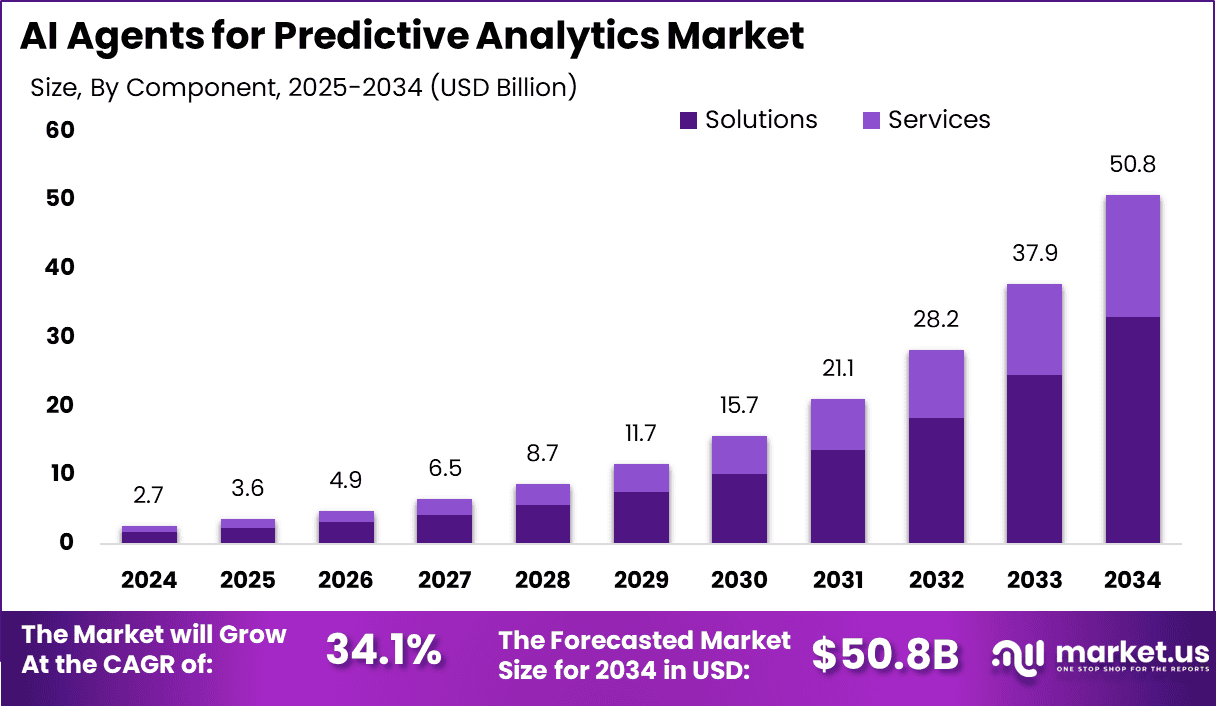Table of Contents
Introduction
The global AI agents for predictive analytics market is projected to surge from USD 2.7 billion in 2024 to USD 50.8 billion by 2034, exhibiting a CAGR of 34.1%. In 2024, North America dominated the market with over 38% share, generating approximately USD 1.0 billion in revenue. The rapid growth is fueled by increasing adoption of AI-driven predictive tools across sectors, growing demand for data-driven decision-making, and advances in machine learning and automation technologies that enhance forecasting accuracy and operational efficiency worldwide.

How Tariffs Are Impacting the Economy
Tariffs on semiconductor components, AI hardware, and software licenses essential to AI agents increase production and operational costs, translating into higher prices for businesses and end-users. This inflationary effect can reduce corporate spending on AI adoption, slowing digital transformation and innovation.
➤ Discover how our research uncovers business opportunities @ https://market.us/report/ai-agents-for-predictive-analytics-market/free-sample/
(Use corporate mail ID for quicker response)
Tariffs disrupt global supply chains, compelling companies to diversify sourcing or relocate manufacturing, often at increased expenses and longer lead times. Retaliatory tariffs intensify trade tensions and market uncertainty, discouraging investment and collaboration. These dynamics collectively hinder the widespread deployment of AI predictive analytics, impacting productivity gains and economic growth across industries reliant on advanced data analytics.

Impact on Global Businesses
Businesses leveraging AI agents for predictive analytics face increased costs due to tariffs on critical hardware and software components. Supply chain realignments add operational complexity and capital expenditure. Industries such as finance, healthcare, and manufacturing experience delays in AI implementation, affecting competitive positioning and efficiency. Emerging markets reliant on imports face adoption challenges due to higher costs and limited access. Companies must invest in supply chain diversification, cloud-based AI solutions, and cost-efficient innovations to sustain growth and meet evolving market demands amid tariff pressures.
Strategies for Businesses
Organizations mitigate tariff impacts by diversifying suppliers and expanding regional manufacturing capabilities. Embracing cloud-based AI platforms reduces hardware dependency and improves scalability. Utilizing predictive analytics supports tariff risk forecasting and inventory optimization. Forming strategic partnerships with technology providers and regional players enhances supply chain resilience. Automation and process innovation lower operational expenses. Active policy engagement aims to influence trade regulations favorably. Agility, innovation, and collaboration are essential for navigating tariff-related challenges and maintaining competitive advantage.
Key Takeaways
- AI agents for predictive analytics market expected to grow at 34.1% CAGR through 2034
- Tariffs raise costs and disrupt supply chains for AI components
- Deployment delays affect operational efficiency and competitive edge
- Supply diversification and cloud adoption mitigate tariff impacts
- Predictive analytics aids proactive tariff risk management
➤ Get full PDF access here @ https://market.us/purchase-report/?report_id=149053
Analyst Viewpoint
The AI agents for predictive analytics market is poised for rapid expansion driven by growing demand for data-driven insights and automation. While tariffs impose cost and supply challenges, they also accelerate innovation in cloud adoption and supplier diversification. Market leaders prioritize scalable, flexible solutions and strategic partnerships. The future outlook remains highly positive as industries increasingly invest in AI-powered predictive capabilities to drive growth and efficiency.
Regional Analysis
North America leads with a 38% market share in 2024, driven by advanced AI infrastructure and high adoption rates in finance, healthcare, and manufacturing. The U.S. dominates regional growth due to substantial investments in AI research and enterprise deployment. Europe exhibits steady growth, supported by regulatory frameworks and innovation ecosystems. Asia-Pacific shows rapid potential fueled by digital transformation and expanding industrial sectors. Regional disparities arise from varying technological maturity, policy environments, and investment capacities.
➤ Discover More Trending Research
Business Opportunities
Opportunities abound in developing cloud-based, scalable AI predictive analytics platforms for diverse industries. Emerging markets offer growth potential as digital infrastructure improves. Integration with IoT and big data enhances analytics capabilities. Collaborations between AI providers and industry verticals enable customized solutions. Additionally, AI-driven risk management and operational optimization services open new revenue streams, driving broader adoption and innovation.
Key Segmentation
Component
- Software
- Hardware
- Services
Deployment Mode
- Cloud-based
- On-premises
Application
- Risk Management
- Customer Analytics
- Supply Chain Optimization
- Fraud Detection
Industry
- BFSI
- Healthcare
- Retail
- Manufacturing
- Others
Key Player Analysis
Leading companies invest heavily in developing advanced AI algorithms and scalable cloud platforms. Strategic partnerships with enterprise clients and technology vendors expand market penetration. Emphasis on interoperability, cybersecurity, and regulatory compliance strengthens competitive positioning. Market leaders focus on innovation, user experience, and regional expansion to sustain growth. Continuous R&D and customer-centric approaches maintain leadership in a rapidly evolving market.
Recent Developments
In 2025, key providers launched enhanced AI-driven predictive analytics platforms with improved real-time processing and multi-industry applications. Strategic alliances with cloud service providers expanded service accessibility. Increased focus on data privacy and compliance enhanced market trust.
Conclusion
The AI agents for predictive analytics market is set for exponential growth fueled by AI adoption and digital transformation. Tariff-related challenges drive innovation and supply chain diversification. Continued investments in cloud and AI technologies will sustain long-term market expansion.
Discuss your needs with our analyst
Please share your requirements with more details so our analyst can check if they can solve your problem(s)



